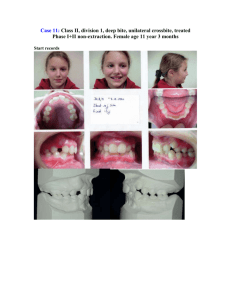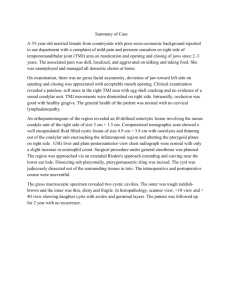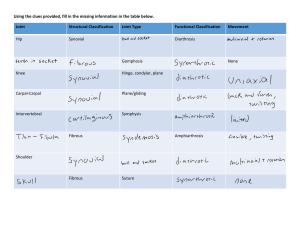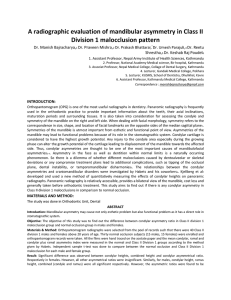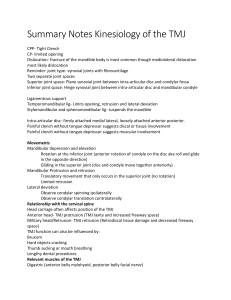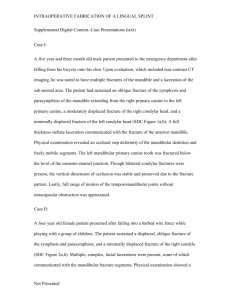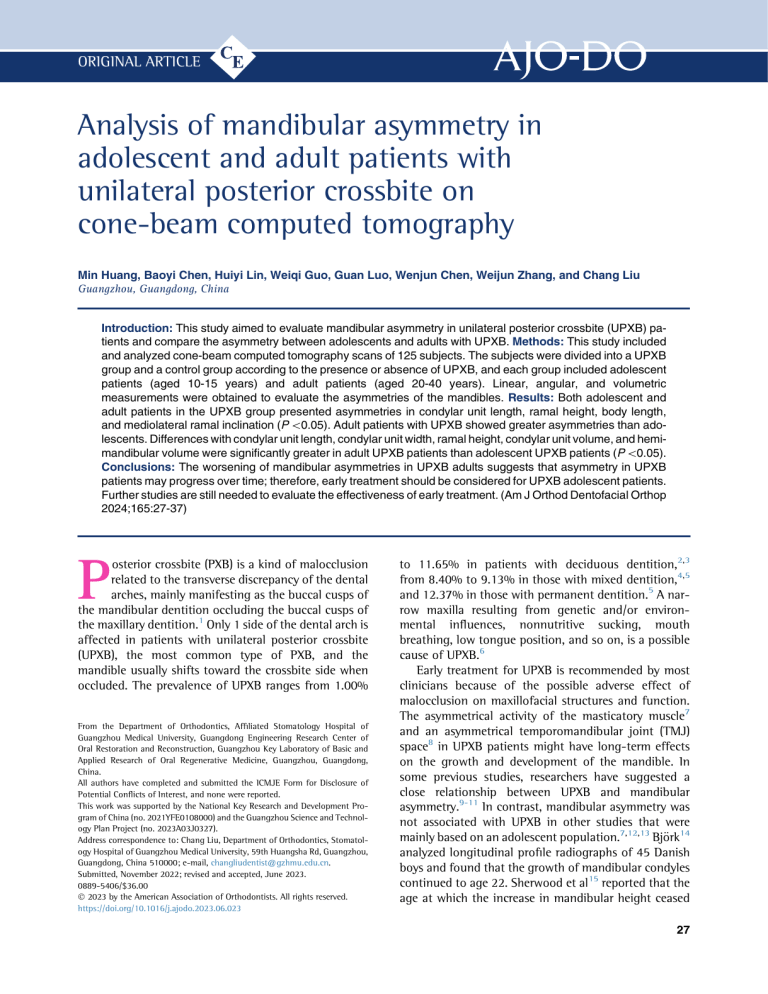
ORIGINAL ARTICLE Analysis of mandibular asymmetry in adolescent and adult patients with unilateral posterior crossbite on cone-beam computed tomography Min Huang, Baoyi Chen, Huiyi Lin, Weiqi Guo, Guan Luo, Wenjun Chen, Weijun Zhang, and Chang Liu Guangzhou, Guangdong, China Introduction: This study aimed to evaluate mandibular asymmetry in unilateral posterior crossbite (UPXB) patients and compare the asymmetry between adolescents and adults with UPXB. Methods: This study included and analyzed cone-beam computed tomography scans of 125 subjects. The subjects were divided into a UPXB group and a control group according to the presence or absence of UPXB, and each group included adolescent patients (aged 10-15 years) and adult patients (aged 20-40 years). Linear, angular, and volumetric measurements were obtained to evaluate the asymmetries of the mandibles. Results: Both adolescent and adult patients in the UPXB group presented asymmetries in condylar unit length, ramal height, body length, and mediolateral ramal inclination (P \0.05). Adult patients with UPXB showed greater asymmetries than adolescents. Differences with condylar unit length, condylar unit width, ramal height, condylar unit volume, and hemimandibular volume were significantly greater in adult UPXB patients than adolescent UPXB patients (P \0.05). Conclusions: The worsening of mandibular asymmetries in UPXB adults suggests that asymmetry in UPXB patients may progress over time; therefore, early treatment should be considered for UPXB adolescent patients. Further studies are still needed to evaluate the effectiveness of early treatment. (Am J Orthod Dentofacial Orthop 2024;165:27-37) P osterior crossbite (PXB) is a kind of malocclusion related to the transverse discrepancy of the dental arches, mainly manifesting as the buccal cusps of the mandibular dentition occluding the buccal cusps of the maxillary dentition.1 Only 1 side of the dental arch is affected in patients with unilateral posterior crossbite (UPXB), the most common type of PXB, and the mandible usually shifts toward the crossbite side when occluded. The prevalence of UPXB ranges from 1.00% From the Department of Orthodontics, Affiliated Stomatology Hospital of Guangzhou Medical University, Guangdong Engineering Research Center of Oral Restoration and Reconstruction, Guangzhou Key Laboratory of Basic and Applied Research of Oral Regenerative Medicine, Guangzhou, Guangdong, China. All authors have completed and submitted the ICMJE Form for Disclosure of Potential Conflicts of Interest, and none were reported. This work was supported by the National Key Research and Development Program of China (no. 2021YFE0108000) and the Guangzhou Science and Technology Plan Project (no. 2023A03J0327). Address correspondence to: Chang Liu, Department of Orthodontics, Stomatology Hospital of Guangzhou Medical University, 59th Huangsha Rd, Guangzhou, Guangdong, China 510000; e-mail, changliudentist@gzhmu.edu.cn. Submitted, November 2022; revised and accepted, June 2023. 0889-5406/$36.00 Ó 2023 by the American Association of Orthodontists. All rights reserved. https://doi.org/10.1016/j.ajodo.2023.06.023 to 11.65% in patients with deciduous dentition,2,3 from 8.40% to 9.13% in those with mixed dentition,4,5 and 12.37% in those with permanent dentition.5 A narrow maxilla resulting from genetic and/or environmental influences, nonnutritive sucking, mouth breathing, low tongue position, and so on, is a possible cause of UPXB.6 Early treatment for UPXB is recommended by most clinicians because of the possible adverse effect of malocclusion on maxillofacial structures and function. The asymmetrical activity of the masticatory muscle7 and an asymmetrical temporomandibular joint (TMJ) space8 in UPXB patients might have long-term effects on the growth and development of the mandible. In some previous studies, researchers have suggested a close relationship between UPXB and mandibular asymmetry.9-11 In contrast, mandibular asymmetry was not associated with UPXB in other studies that were mainly based on an adolescent population.7,12,13 Bj€ ork14 analyzed longitudinal profile radiographs of 45 Danish boys and found that the growth of mandibular condyles continued to age 22. Sherwood et al15 reported that the age at which the increase in mandibular height ceased 27 Huang et al 28 was 24.58 years and 23.37 years for males and females, respectively. Accordingly, the continuous growth of the mandible in UPXB adolescents may worsen the deformation of the mandible. However, Evangelista et al16 found 3 different age groups (children, adolescents, and adults) in patients with a skeletal Class I relationship with UPXB had surprisingly similar slight mandibular asymmetries. Hence, it is important to understand the effect of growth on mandibular symmetry by grouping UPXB patients according to biological age and developmental stages. Various methods have been proposed to evaluate mandibular asymmetry. Lopatien_e and Trumpyt_e10 and Kasimoglu et al17 used panoramic radiographs to assess condylar and ramal height asymmetry in UPXB patients. Although less invasive, a major limitation of panoramic radiographs is the unequal magnification of the right and left sides in the horizontal dimension if the midsagittal plane (MSP) of the patient’s head is not positioned in the rotational midline of the machine.18 Submentovertex radiographs were also used to evaluate structural, positional, and dentoalveolar asymmetry of the mandible in patients with PUXB.8,19 However, 2-dimensional measurement tools cannot compensate for distortion, magnification, and superimposition. Cone-beam computed tomography (CBCT) has been widely used in dental research as a reliable and accurate method for quantitative analysis of jaw deformity.20 Enlow and Hans21 proposed a theory of craniofacial growth, which suggested that different regional areas have different local developmental and functional and structural conditions; therefore, regional signals activate local osteogenic tissues to adapt as a part of overall growth. It is reasonable to assume that functional changes in UPXB patients might cause a continuous imbalanced signal that perpetually alters the development and growth of the mandible. Therefore, this study aimed to compare the shape and morphology of mandibles between adolescent and adult patients with or without UPXB. The following null hypothesis was tested: there are no significant differences in the shape and morphology of the mandible between adolescent and adult patients with UPXB. MATERIAL AND METHODS This study is a cross-sectional study. CBCT scans of 125 subjects were included in this study and analyzed. The subjects were divided into a UPXB group and a control group according to the presence or absence of UPXB, and each group included adolescents (aged 10-5 years; n 5 29 in the control group and n 5 38 in the UPXB group) and adult (aged 20-40 years; n 5 29 in each group) subjects. Adolescents with UPXB were then subdivided according to different cervical vertebral January 2024 Vol 165 Issue 1 maturation stages (CVMSs) proposed by Baccetti et al.22 All subjects were selected from a large pool of patients who were sequentially admitted for orthodontic treatment from 2015 to 2023 in our institution. This study was approved by the Research and Ethics Committee of the Affiliated Stomatology Hospital of Guangzhou Medical University (no. LCYJ2022005). The inclusion criteria for the UPXB group were as follows: (1) UPXB involving at least 2 posterior teeth, (2) no history of orthodontic treatment, (3) no prostheses, (4) no absence of permanent teeth (except third molars) and no early loss of primary teeth. The exclusion criteria were as follows: (1) signs of a TMJ disorder, (2) history of orthodontic or facial surgical procedures, (3) pathologic conditions in the craniomaxillofacial complex, (4) congenital craniofacial deformities, (5) signs of maxillofacial trauma, and (6) diagnosed with a systemic disease. The inclusion and exclusion criteria of the control group were the same as those for the UPXB group, except for the absence of PUXB. The patient characteristics of the control and UPXB groups are listed in Table I. The CBCT scans were obtained using NewTom (QR srl, Verona, Italy), and the imaging parameters were as follows: 110 kV, 3.07 mA, a scan time of 18 seconds, a voxel size of 0.3 mm and a focal spot of 0.3 mm. Images were saved in digital imaging and communications in medicine format. These data were reconstructed into 3-dimensional (3D) images using Mimics Research software (version 20.0; Materialise NV, Liege, Belgium). The mandibles were separated from the whole image, and the teeth above the alveolar bone in the mandibles were removed. All landmark identifications and measurements were made by this software. Landmarks and measurements were selected according to previous studies.23-25 Landmarks (Table II) were designated on the surface of reconstructed 3D images and were verified on the axial, coronal, and sagittal views. The following planes were identified: (1) the Frankfort horizontal plane (FH plane): the plane passing through bilateral Or and left Po; (2) the MSP: the plane passing through N, Ba, and perpendicular to the FH plane; (3) the frontal plane: the plane passing through N and perpendicular to the FH plane and the MSP; (4) the Sig plane: the plane passing through the sigmoid notch (Sig) and parallel to the FH plane; (5) the Gomid-Jlat-Jmed plane: the plane passing through Gomid, Jlat, and Jmed; (6) the B-Me-G plane: the plane passing through B, Me and G; (7) the Mid-mandibular plane (MMP): the plane passing through the MGo and Me and perpendicular to the mandibular plane. All the measurements are shown in Figure. Linear measurements (Fig) were as follows: (1) mandibular deviation: distance from Me to the MSP; (2) condylar unit length: American Journal of Orthodontics and Dentofacial Orthopedics Huang et al 29 Table I. Characteristics of the patients in the control group and UPXB group Adolescents (aged 10-15 y) Adults (aged 20-40 y) UPXB Characteristics Number Age (y) Sex Male Female Crossbite side Right Left Mandibular deviation (mm) Mean 6 SD P value Mandibular rotation ( ) Mean 6 SD P value Control 29 12.97 6 1.16 CVMS I1II 19 10.79 6 0.98 CVMS III 19 13.84 6 1.07 Control 29 24.97 6 4.69 UPXB 29 23.75 6 3.14 6 23 6 13 5 14 11 18 11 18 – – 8 11 8 11 – – 16 13 0.91 6 0.58 2.75 6 1.84 0.001*** 3.39 6 2.32 0.001*** 0.88 6 0.49 0.001*** 4.73 6 2.40 1.24 6 0.99 2.30 6 1.63 0.019* 2.31 6 1.94 0.015* 0.92 6 0.72 0.001*** 2.97 6 1.93 Note. Values are presented as mean 6 SD. An independent Student t test was used to analyze differences between the control and UPXB groups. SD, standard deviation. *P \0.05; ***P \0.001. Consup-F; (3) coronoid unit length: Corsup-F; (4) angular unit length: F-Gomid; (5) body unit length: F-MF; (6) chin unit length: MF-Pog; (7) condylar width: ConmedConlat; (8) ramal height: Consup-Gomid; and (9) body length: Gomid-Me. Angular measurements (Fig) were as follows: (1) mandibular rotation: the intersection angle between the MSP and the MMP; (2) gonial angle: the angle between the Me-Gomid and Consup-Gomid vectors of both sides; (3) mediolateral ramal inclination: the inner angle between the right and left Consup-Gomid and the FH plane projected on the frontal plane; (4) anteroposterior ramal inclination: the inner angle between the right and left Consup-Gomid and the FH plane projected on the MSP plane; (5) condylar angle to the MSP: the inner angle between the right and left Conmed-Conlat and the MSP plane projected on the FH plane. Volumetric measurements (Fig) were as follows: (1) hemimandibular volume: the mandibular volume was divided into 2 hemimandibular volumes by the B-Me-G plane; (2) body unit volume and hemiramal volume: the hemimandibular volume was divided into the body unit volume and the hemiramal volume by the Gomid-Jlat-Jmedplane; (3) condylar unit volume: coronoid unit volume and ramal unit volume: the hemiramal volume was divided into the condylar unit volume, the coronoid unit volume and the ramal unit volume by the Sig plane. Statistical analysis PASS software (version 15.0; NCSS, LLC, Kaysville, Utah) was used to estimate the minimum sample size (power 5 0.8; a 5 0.05) on the basis of the pilot and previous studies.9 The intraclass correlation coefficient (ICC) was used to assess the intraoperator and interoperator error. To determine the intraoperator error, thirty-five 3D images were randomly selected, and the entire workflow, including separation of the mandible and landmark identifications, was repeated by the same operator (M.H.) 2 weeks apart. To evaluate the interoperator error, a second blinded experienced operator (B.C.) analyzed 35 randomly selected CBCT images and repeated the workflow sequence. The statistical analysis was performed with SPSS software (version 26.0; IBM, Armonk, NY). Descriptive statistics were calculated for all variables, including mean and standard deviation. The difference between the measurements of the 2 sides was the right side minus the left side in the control group and the noncrossbite (non-XB) side minus the crossbite (XB) side in the UPXB group. Positive difference values in the control group indicated that the measurements on the right side were larger than those on the left side, and in the UPXB group, the measurements on the non-XB side were larger than those on the XB side. The data were then checked for normal distribution by the ShapiroWilk test. As all the data were normally distributed, parametric tests were used. The paired t test was performed to compare the intragroup differences between the measurements. An independent Student t test was used to compare the mandibular measurement differences between sides among groups. Because no significant American Journal of Orthodontics and Dentofacial Orthopedics January 2024 Vol 165 Issue 1 Huang et al 30 Table II. Description of landmarks Landmark Definition Consup (condylion superius) The most superior point of the condylar head Conmed (condylion medialis) The most medial point of the condylar head Conlat (condylion lateralis) The most lateral point of the condylar head Corsup (coronoid superius) The most superior point of the coronoid process Sig (sigmoid notch) The most inferior point of the sigmoid notch F (fossa of mandibular The most inferior point on the fossa of foramen) the mandibular foramen Jlat The most lateral and deepest point of the curvature formed at the junction of the mandibular ramus and body Jmed The most medial and deepest point of the curvature formed at the junction of the mandibular ramus and body Gopost (gonion posterius) The most posterior point on the mandibular angle Gomid (gonion midpoint) The midpoint between the Gopost and Goinf on the mandibular angle Goinf (gonion inferius) The most inferior point on the mandibular angle MGo The midpoint between the left and right Gomid MF (mental foramen) The entrance of the mental foramen Me (menton) The most inferior midpoint on the symphysis Pog (pogonion) The most anterior midpoint on the symphysis B (supramentale) The midpoint of the greatest concavity on the anterior border of the symphysis G (genial tubercle) The midpoint on the genial tubercle N (Nasion) Most anterior and median point of the frontonasal suture Or (Orbitale) The deepest point on the infraorbital margin Po (Porion) The highest point on the roof of the external auditory meatus Ba (Basion) The middle point on the anterior rim of the occipital foramen difference could be detected for any measurement differences between CVMS I 1 CVMS II and CVMS III subjects, all the measurements were pooled in subsequent analysis. P values \0.05 were considered statistically significant. RESULTS All 3D measurements showed high intraoperator and interoperator agreements. The intraoperator ICC ranged January 2024 Vol 165 Issue 1 from 0.982% (for body unit volume) to 0.998% (for body unit length), and the interoperator ICC ranged from 0.816% (for body unit volume) to 0.977% (for coronoid unit length). Table I shows that patients in the UPXB group presented significantly greater mandibular deviation and rotation than subjects in the same age range in the control group. A significantly larger coronoid unit length and a shorter body length were detected on the XB side than on the non-XB side in both CVMS I 1 CVMS II and CVMS III subjects. Although the condylar unit length was larger on the non-XB side in CVMS I 1 CVMS II patients, the statistical significance for condylar unit length was found only in CVMS III patients. None of the measurement differences significantly differed between CVMS I 1 II and CVMS III subjects (Table III). The adolescents in the control group had significantly greater ramal heights on the right side than on the left (P \0.01; Table IV). In the adolescent UPXB patients, 4 linear variables (condylar unit length, coronoid unit length, ramal height, body length), 2 angular variables (mediolateral ramal inclination, anteroposterior ramal inclination), and one volumetric measurement (condylar unit volume) were significantly different between the 2 sides (P \0.05). Among the 4 linear measurements with statistical significance, condylar unit length, coronoid unit length, and body length were considerably different between the 2 sides (P \0.01). The condylar unit length, ramal height, body length, and condylar unit volume were remarkably larger on the non-XB side than on the XB side (Table V). Significantly greater chin unit length and condylar width were found on the right side of adults in the control group (P \0.05; Table VI). In adult UPXB patients, 4 linear variables (condylar unit length, condylar width, ramal height, body length), one angular variable (mediolateral ramal inclination), and 3 volumetric measurements (condylar unit volume, hemiramal volume, and hemimandibular volume) were significantly different between the 2 sides (P \0.05). Among these statistically significant measurements, 7 variables were significantly larger on the non-XB side than on the XB side, except for mediolateral ramal inclination (P \0.01) (Table VII). There were no significant differences in measurements between the adolescents and adults in the control group (Table VIII). Significantly larger measurement differences were detected in the adult UPXB subjects than in the adolescent UPXB subjects in terms of condylar unit length difference, condylar width difference, ramal height difference, condylar unit volume difference, and hemimandibular volume difference (P \0.05). The adult UPXB subjects showed a remarkably smaller coronoid unit length difference than the adolescent UPXB American Journal of Orthodontics and Dentofacial Orthopedics Huang et al 31 Fig. Measurements used in this study: A, Linear and angular measurements: a, condylar unit length; b, body unit length; c, coronoid unit length; d, angular unit length; e, chin unit length; f, anteroposterior ramal inclination; g, gonial angle; B, Linear and angular measurements: h, condylar width; i, ramal height; j, body length; k, mediolateral ramal inclination; C, Linear and angular measurements: l, mandibular deviation; m, condylar angle to MSP; n, mandibular rotation; D, Volumetric measurements used in this study: 1, condylar unit volume; 2, coronoid unit volume; 3, ramal unit volume; 4, body unit volume; 11213, hemiramal volume; 1121314, hemimandibular volume. patients (P \0.01). Significantly greater coronoid unit and body length differences were detected in adolescent UPXB subjects than in adolescents without UPXB. When the adults with or without UPXB were compared, the UPXB adults presented markedly larger condylar unit length difference, ramal height difference, body length difference, condylar unit volume difference, hemiramal volume difference, and hemimandibular volume difference (P \0.05) (Table VIII). DISCUSSION It is well-known that unilateral posterior crossbite in children can result in possible asymmetrical growth of the skeletal structures; thus, early treatment for UPXB is recommended in clinical practice. However, whether UPXB will lead to increasingly severe mandibular skeletal asymmetry over time remains unclear. Previous studies on the relationship between the UPXB and skeletal asymmetry showed controversial results, and one important confounding factor could have been the heterogeneous age of samples.7 In this study, the UPXB subjects were categorized according to biological age and CVMS to investigate whether the mandibular skeletal asymmetries in UPXB patients progress during growth. Baccetti et al22 reported that the timing of the pubertal growth peak occurs between CVMS II and CVMS III. A American Journal of Orthodontics and Dentofacial Orthopedics January 2024 Vol 165 Issue 1 32 January 2024 Vol 165 Issue 1 Table III. Comparison of the measurements in adolescent UPXB patients with different CVMSs CVMS I 1 CVMS II (n 5 19) XB side Non-XB side Difference P value XB side Non-XB side Difference P valueƚ P valuey 39.58 6 3.99 53.10 6 3.27 35.7 6 3.53 17.01 6 2.28 28.47 6 2.03 17.29 6 1.95 50.34 6 4.86 78.33 6 4.71 40.46 6 3.55 53.65 6 3.66 35.02 6 3.51 17.18 6 2.98 28.31 6 2.46 17.35 6 2.31 51.17 6 6.12 79.21 6 4.77 0.89 6 2.13 0.55 6 1.68 0.68 6 1.27 0.16 6 1.71 0.16 6 1.12 0.05 6 1.39 0.83 6 2.66 0.88 6 1.62 0.086 0.172 0.031* 0.679 0.542 0.870 0.190 0.030* 42.43 6 3.77 54.43 6 2.17 39.55 6 3.59 19.25 6 2.48 28.69 6 1.86 17.22 6 2.29 54.53 6 4.55 81.47 6 4.03 43.74 6 4.17 54.78 6 2.71 38.79 6 3.00 19.18 6 2.52 29.42 6 1.29 17.47 6 1.89 55.68 6 3.40 82.67 6 4.41 1.31 6 2.22 0.35 6 2.06 0.75 6 1.42 0.07 6 1.25 0.73 6 1.36 0.25 6 1.20 1.14 6 3.01 1.20 6 2.30 0.019* 0.468 0.033* 0.814 0.072 0.375 0.114 0.036* 0.553 0.749 0.864 0.634 0.062 0.642 0.735 0.622 124.34 6 4.67 81.15 6 4.23 80.90 6 3.94 72.58 6 6.52 125.11 6 4.84 79.99 6 3.92 80.19 6 4.88 72.18 6 7.74 0.76 6 1.95 1.16 6 3.29 0.71 6 2.21 0.40 6 5.81 0.106 0.143 0.179 0.768 122.32 6 4.58 83.54 6 3.72 82.49 6 4.34 70.63 6 9.32 122.96 6 4.51 82.69 6 4.22 81.56 6 4.12 71.93 6 8.29 0.64 6 2.86 0.85 6 2.40 0.93 6 2.44 1.30 6 6.43 0.350 0.140 0.110 0.389 0.874 0.746 0.772 0.398 1.33 6 0.27 0.18 6 0.06 5.48 6 1.40 16.47 6 2.59 6.62 6 1.71 23.17 6 3.68 1.42 6 0.40 0.17 6 0.06 5.55 6 1.64 16.39 6 2.71 6.77 6 1.96 23.24 6 4.10 0.09 6 0.23 0.01 6 0.05 0.08 6 0.52 0.08 6 0.62 0.15 6 0.64 0.07 6 1.01 0.110 0.640 0.530 0.596 0.335 0.758 1.40 6 0.40 0.29 6 0.11 6.33 6 1.39 18.32 6 1.98 7.65 6 1.79 25.97 6 3.41 1.50 6 0.35 0.28 6 0.10 6.34 6 1.49 18.46 6 2.17 7.78 6 1.83 26.22 6 3.65 0.10 6 0.28 0.01 6 0.06 0.02 6 0.52 0.14 6 0.58 0.13 6 0.57 0.25 6 0.87 0.138 0.388 0.881 0.299 0.336 0.223 0.922 0.707 0.732 0.269 0.940 0.562 Note. Values are presented as mean 6 standard deviation. The difference is defined as the non-XB side XB side. y Paired t test between the XB side and the non-XB side; zIndependent Student t test between the measurement differences of different CVMSs; *P \0.05. Huang et al American Journal of Orthodontics and Dentofacial Orthopedics Measurements Linear measurements (mm) Condylar unit length Body unit length Coronoid unit length Angular unit length Chin unit length Condylar width Ramal height Body length Angular measurements ( ) Gonial angle Mediolateral ramal inclination Anteroposterior ramal inclination Condylar angle to MSP Volumetric measurements (103 mm3) Condylar unit volume Coronoid unit volume Ramal unit volume Body unit volume Hemiramal volume Hemimandibular volume CVMS III (n 5 19) y Huang et al 33 Table IV. Comparison of the measurements between the left and right sides (paired t test) in the adolescents in the control group Aged 10-15 y Measurements Linear measurements (mm) Condylar unit length Body unit length Coronoid unit length Angular unit length Chin unit length Condylar width Ramal height Body length Angular measurements ( ) Gonial angle Mediolateral ramal inclination Anteroposterior ramal inclination Condylar angle to MSP Volumetric measurements (103 mm3) Condylar unit volume Coronoid unit volume Ramal unit volume Body unit volume Hemiramal volume Hemimandibular volume 95% Confidence interval P value 0.32 6 1.34 0.00 6 1.48 0.31 6 1.38 0.36 6 1.29 0.31 6 1.13 0.03 6 0.98 0.65 6 0.94 0.14 6 1.33 0.19 to 0.83 0.56 to 0.57 0.21 to 0.84 0.13 to 0.85 0.12 to 0.74 0.35 to 0.40 0.29 to 1.01 0.37 to 0.64 0.214 0.989 0.232 0.144 0.146 0.891 0.001** 0.588 120.36 6 4.70 83.03 6 3.27 83.89 6 4.15 71.91 6 7.11 0.04 6 2.26 0.73 6 2.25 0.10 6 1.82 1.75 6 5.91 0.82 to 0.90 1.59 to 0.12 0.79 to 0.59 4.00 to 0.49 0.920 0.090 0.766 0.121 1.47 6 0.28 0.26 6 0.10 6.31 6 1.32 19.44 6 2.73 8.17 6 1.58 27.93 6 4.04 0.02 6 0.12 0.01 6 0.05 0.01 6 0.36 0.11 6 0.53 0.04 6 0.43 0.08 6 0.70 0.02 to 0.06 0.00 to 0.04 0.13 to 0.15 0.32 to 0.09 0.12 to 0.20 0.35 to 0.18 0.367 0.202 0.900 0.259 0.625 0.524 Left side Right side 42.11 6 3.67 54.47 6 4.33 38.65 6 3.40 19.24 6 2.68 28.29 6 1.58 17.36 6 2.27 53.74 6 4.76 82.29 6 4.61 42.42 6 3.34 54.47 6 4.11 38.96 6 3.30 19.6 6 2.74 28.6 6 1.40 17.39 6 2.28 54.39 6 4.84 82.42 6 4.35 120.32 6 5.24 83.76 6 3.46 83.99 6 3.88 73.67 6 6.22 1.45 6 0.26 0.25 6 0.09 6.3 6 1.35 19.56 6 2.80 8.13 6 1.60 28.01 6 4.18 Difference Note. Values are presented as mean 6 standard deviation. The difference is defined as the right left side. **P \0.01. Table V. Comparison of the measurements between the XB and non-CB sides (paired t test) in the adolescents in the UPXB group Aged 10-15 y Measurements Linear measurements (mm) Condylar unit length Body unit length Coronoid unit length Angular unit length Chin unit length Condylar width Ramal height Body length Angular measurements ( ) Gonial angle Mediolateral ramal inclination Anteroposterior ramal inclination Condylar angle to MSP Volumetric measurements (103 mm3) Condylar unit volume Coronoid unit volume Ramal unit volume Body unit volume Hemiramal volume Hemimandibular volume XB side Non-XB side Difference 95% Confidence interval P value 41.00 6 4.09 53.77 6 2.82 37.62 6 4.01 18.13 6 2.61 28.58 6 1.92 17.26 6 2.10 52.43 6 5.11 79.90 6 4.61 42.10 6 4.16 54.22 6 3.23 36.91 6 3.74 18.18 6 2.90 28.86 6 2.04 17.41 6 2.08 53.42 6 5.39 80.94 6 4.86 1.10 6 2.15 0.45 6 1.86 0.72 6 1.33 0.05 6 1.48 0.28 6 1.47 0.15 6 1.29 0.99 6 2.80 1.04 6 1.97 0.39-1.81 0.16 to 1.06 1.15 to 0.28 0.44 to 0.54 0.20 to 0.76 0.27 to 0.58 0.07-1.91 0.39-1.69 0.003** 0.145 0.002** 0.842 0.242 0.469 0.036* 0.003** 123.33 6 4.67 82.34 6 4.11 81.69 6 4.17 71.61 6 8.00 124.03 6 4.74 81.34 6 4.24 80.87 6 4.51 72.06 6 7.91 0.70 6 2.42 1.00 6 2.84 0.82 6 2.30 0.45 6 6.10 0.0961 to 1.494 1.9392 to 0.0703 1.5759 to 0.0635 1.5555 to 2.4566 0.083 0.036* 0.034* 0.652 1.37 6 0.34 0.24 6 0.10 5.90 6 1.44 17.39 6 2.46 7.14 6 1.80 24.57 6 3.77 1.46 6 0.37 0.23 6 0.10 5.95 6 1.59 17.43 6 2.46 7.27 6 1.94 24.73 6 4.11 0.10 6 0.25 0.01 6 0.05 0.05 6 0.52 0.03 6 0.60 0.14 6 0.60 0.16 6 0.94 0.01-0.18 0.03 to 0.01 0.12 to 0.22 0.17 to 0.23 0.06 to 0.33 0.15 to 0.47 0.026* 0.327 0.574 0.742 0.165 0.292 Note. Values are presented as mean 6 standard deviation. The difference is defined as the non-XB side XB side. *P \0.05; **P \0.01. American Journal of Orthodontics and Dentofacial Orthopedics January 2024 Vol 165 Issue 1 Huang et al 34 Table VI. Comparison of the measurements between the left and right sides (paired t test) in the adults in the control group Aged 20-40 y Measurements Linear measurements (mm) Condylar unit length Body unit length Coronoid unit length Angular unit length Chin unit length Condylar width Ramal height Body length Angular measurements ( ) Gonial angle Mediolateral ramal inclination Anteroposterior ramal inclination Condylar angle to MSP Volumetric measurements (103 mm3) Condylar unit volume Coronoid unit volume Ramal unit volume Body unit volume Hemiramal volume Hemimandibular volume Left side Right side Difference 95% Confidence interval P value 43.22 6 2.67 55.74 6 2.90 40.65 6 3.58 22.05 6 3.13 28.61 6 1.72 20.16 6 2.24 57.36 6 4.69 84.76 6 3.42 43.79 6 3.08 55.52 6 2.73 41.12 6 3.51 22.01 6 3.00 28.95 6 1.80 20.66 6 2.10 57.86 6 4.43 84.82 6 4.02 0.57 6 1.54 0.21 6 1.26 0.47 6 1.44 0.04 6 1.27 0.34 6 0.81 0.50 6 0.96 0.51 6 1.53 0.06 6 1.40 0.02 to 1.16 0.07 to 1.02 0.69 to 0.26 0.52 to 0.44 0.03-0.65 0.13-0.86 0.08 to 1.09 0.47 to 0.59 0.056 0.365 0.088 0.868 0.032* 0.009** 0.086 0.813 117.20 6 5.23 81.82 6 4.30 85.24 6 3.36 74.18 6 6.78 117.63 6 5.68 80.76 6 5.84 85.04 6 3.16 73.94 6 7.03 0.43 6 2.39 1.06 6 3.20 0.20 6 2.08 0.24 6 4.30 0.48 to 1.34 2.28 to 0.16 0.99 to 0.59 1.87 to 1.40 0.337 0.086 0.616 0.766 1.81 6 0.52 0.30 6 0.16 7.22 6 1.51 21.09 6 3.34 9.48 6 1.98 30.90 6 5.16 1.85 6 0.48 0.31 6 0.14 7.21 6 1.53 21.11 6 3.33 9.53 6 1.90 30.97 6 5.09 0.05 6 0.19 0.01 6 0.07 0.01 6 0.56 0.01 6 0.76 0.05 6 0.61 0.07 6 1.03 0.03 to 0.12 0.01 to 0.04 0.22 to 0.20 0.28 to 0.30 0.18 to 0.29 0.32 to 0.46 0.214 0.367 0.913 0.920 0.651 0.720 Note. Values are presented as mean 6 standard deviation. The difference is defined as the right left side. *P \0.05; **P \0.01. rapid increase in mandibular length and the greatest bone apposition at the condyle are closely associated with the individual pubertal growth peak.26 Our finding that pubertal growth peak onset could worsen asymmetry in the condylar region in adolescent UPXB patients was in agreement with the above mentioned studies. Condylar cartilage was more vulnerable to imbalances in UPXB adolescents during accelerated growth, which could have led to condylar asymmetry. We noticed that many parameters measured in adolescent UPXB patients with different CVMSs showed no significant difference between the XB and non-XB sides. A limited sample size (n 5 19) might be a reasonable explanation. Further analysis with a larger sample size is needed. The differences between the sides of subjects in different CVMSs were not significant, so the data were combined for subsequent statistical analysis. The differences in several measurements were statistically significant between the right and left sides in the control group, although the differences were tiny (within 1 mm). It is well-known that perfect symmetry is rare, and even faces considered aesthetically pleasing may have some degree of asymmetry.27 The slight rightside predominance observed in the control group was consistent with previous studies.28,29 Muscle and functional asymmetry may be a possible explanation. It was January 2024 Vol 165 Issue 1 reported that humans and higher primates had a rightside preference for chewing.30 The asymmetry of mastication may have progressed to craniofacial asymmetry. Our findings, consistent with previous studies,9,31 showed that UPXB was tightly associated with mandibular skeletal asymmetry. Significant asymmetry was found in the condylar process, mandibular ramus, coronoid process, and mandibular body in patients in the UPXB group. Enlow and Hans21 suggested that osteogenic, fibrogenic, and chondrogenic tissues in respective local growth fields conduct remodeling activities of the mandible. The signals from the composite of all related soft tissue parts and their growth and functioning orchestrated the local remodeling patterns. The asymmetrical activity of the masticatory muscle7 and an asymmetrical TMJ space8 were found in UPXB patients, which might have led to a morphologic alteration of the corresponding skeletal unit in the mandible. We also observed the most prominent asymmetry at the condylar process and ramus. This finding could be explained by some previous studies. Pinto et al8 and Almaqrami et al32 found that the TMJ space was asymmetric in UPXB patients and that the condyle on the non-XB side was relatively more anterior and inferior than that on the crossbite side. Such positional asymmetry may stimulate the condyle on the non-XB side to grow posteriorly and superiorly, which American Journal of Orthodontics and Dentofacial Orthopedics Huang et al 35 Table VII. Comparison of the measurements between the XB and non-CB sides (paired t test) in the adults in the UPXB group Aged 20-40 y Measurements Linear measurements (mm) Condylar unit length Body unit length Coronoid unit length Angular unit length Chin unit length Condylar width Ramal height Body length Angular measurements ( ) Gonial angle Mediolateral ramal inclination Anteroposterior ramal inclination Condylar angle to MSP Volumetric measurements (103 mm3) Condylar unit volume Coronoid unit volume Ramal unit volume Body unit volume Hemiramal volume Hemimandibular volume XB side Non-XB side Difference 95% Confidence interval P value 43.62 6 3.98 57.08 6 4.56 40.88 6 5.09 20.40 6 2.49 29.96 6 2.20 18.62 6 2.74 57.36 6 5.71 84.84 6 5.85 46.95 6 2.77 57.37 6 5.08 41.39 6 4.66 20.55 6 2.93 29.93 6 1.73 19.86 6 2.56 60.25 6 4.25 86.19 6 6.26 3.33 6 2.80 0.29 6 1.99 0.51 6 2.35 0.15 6 1.36 0.03 6 1.53 1.24 6 3.07 2.89 6 3.07 1.35 6 2.24 2.26-4.39 0.46 to 1.05 0.39 to 1.40 0.37 to 0.67 0.61 to 0.55 0.55-1.93 1.72-4.06 0.50-2.21 0.001*** 0.435 0.254 0.550 0.918 0.001** 0.001*** 0.003** 121.10 6 5.02 84.38 6 3.07 80.32 6 6.43 72.73 6 8.40 121.01 6 5.27 82.91 6 4.11 79.56 6 5.65 73.58 6 9.14 0.09 6 2.32 1.45 6 3.56 0.76 6 2.60 0.85 6 8.29 0.97 to 0.80 2.81 to 1.10 1.75 to 0.23 2.31 to 4.00 1.61 6 0.65 0.32 6 0.17 7.24 6 1.76 20.11 6 4.25 8.83 6 2.32 28.67 6 6.25 1.94 6 0.58 0.30 6 0.17 7.49 6 1.66 20.51 6 3.95 9.39 6 2.19 29.66 6 5.96 0.33 6 0.42 0.02 6 0.07 0.25 6 0.73 0.40 6 1.11 0.55 6 1.02 1.00 6 1.69 0.17-0.49 0.04 to 0.01 0.02 to 0.53 0.00 to 0.83 0.17-0.94 0.35-1.64 0.839 0.036* 0.125 0.586 0.001*** 0.147 0.070 0.072 0.007** 0.004** Note. Values are presented as mean 6 standard deviation. The difference is defined as the non-XB side XB side. *P \0.05; **P \0.01; ***P \0.001. is similar to adaptive mechanisms proposed for some functional forward mandibular positioning appliances.33 The sustained input of imbalanced signals activated asymmetrical remodeling of the mandible to adapt to asymmetrical regional circumstances in UPXB subjects; thus, correcting UPXB before the peak of pubertal growth is clinically significant. In our study, adult UPXB patients showed greater asymmetry than adolescent UPXB patients regarding linear and volumetric measurements. These findings were consistent with those found in some previous studies. Kilic et al31 found a significant difference of 1.22 mm in the ramal heights between the 2 sides of adolescent UPXB patients. The difference was smaller than that reported in another study on adult patients.34 In addition, Veli et al35 found no statistically significant difference in volumetric measurements between the 2 sides in adolescent UPXB patients. However, adult UPXB patients seemed to present great asymmetry in volumetric measurements. Leonardi et al9 found a significant difference (1.53 cm3) in the hemimandibular volumes between the 2 sides of PUXB adult patients, similar to these findings. These results implied that the linear asymmetry of the mandible, which can be detected in the early stage of UPXB, was more sensitive than volumetric measurement in the diagnosis of mandibular asymmetry. However, our findings were not consistent with those found in the study by Evangelista et al,16 who did not find any significant difference in mandibular asymmetry between adult and adolescent UPXB patients. This contradiction may be attributed to differences in the inclusion criteria between our studies. Subjects aged 10-15 years were defined as adolescents in our study, and the age range for adolescents in Evangelista et al16 were aged 12-18 years. This discrepancy in age range may contribute to some extent to the disagreement in the results. Moreover, only patients with a skeletal Class I relationship were included Evangelista et al,16 whereas we used samples with different skeletal Classes in our study. The longer period and larger magnitude of mandibular growth in subjects with a skeletal Class III relationship might have led to a higher occurrence of mandibular asymmetry.36 The difference in angular measurements between the sides did not show any significant intergroup differences between the control and UPXB groups or between UPXB patients of different ages. Miresmaeili et al11 did not find asymmetry for mediolateral ramal inclination and condylar angle to MSP between the sides in adult UPXB patients. In addition, our findings implied that the growth direction of the mandible was stable during asymmetric growth in UPXB patients. American Journal of Orthodontics and Dentofacial Orthopedics January 2024 Vol 165 Issue 1 Huang et al 36 Table VIII. Comparison of the differences between the measurements of each side in each group (independent Student t test) Measurements Linear measurement differences (mm) Condylar unit length Body unit length Coronoid unit length Angular unit length Chin unit length Condylar width Ramal height Body length Angular measurement differences ( ) Gonial angle Mediolateral ramal inclination Anteroposterior ramal inclination Condylar angle to MSP Volumetric measurement differences (103 mm3) Condylar unit volume Coronoid unit volume Ramal unit volume Body unit volume Hemiramus volume Hemimandibular volume C1 C2 X1 X2 C1 X1 C2 X2 0.505 \0.001*** 0.073 \0.001*** 0.546 0.741 0.293 0.251 0.667 0.009** 0.003** 0.945 0.239 0.767 0.371 0.580 0.917 0.400 0.873 0.924 0.068 0.006** 0.659 0.059 0.665 0.010* 0.495 0.001** 0.838 0.542 0.029* 0.011* 0.525 0.658 0.184 0.567 0.262 0.675 0.403 0.657 0.854 0.924 0.171 0.363 0.269 0.822 0.143 0.534 0.543 0.952 0.872 0.461 0.929 0.512 0.010* 0.475 0.178 0.127 0.057 0.021* 0.141 0.051 0.730 0.303 0.458 0.240 0.002** 0.096 0.124 0.140 0.028* 0.015* C1, adolescents in the control group (aged 10-15 y); C2, adults in the control group (aged 20-40 y); X1, adolescents in the UPXB group (aged 10-15 y); X2, adults in the UPXB group (aged 20-40 y). *P \0.05; **P \0.01; ***P \0.001. This study also found that the coronoid unit length in adolescents with UPXB was asymmetrical and that the XB side was larger than the non-XB side. This finding was in accordance with that of Cardinal et al.13 Greater electromyographic activity of the anterior temporalis (AT) on the crossbite side may be one possible explanation. Kecik et al37 found that UPXB patients showed higher AT activity during resting and maximum clenching on the XB side than on the non-XB side. As the temporalis muscle inserts directly onto the coronoid process of the mandible, higher electromyographic activity of AT on the crossbite side might act as a signal activating bone deposition of the coronoid process. However, no significant difference in coronoid unit length between sides was found in the UPXB adult group, consistent with Leonardi et al.9 Adaptive change might occur in the temporalis over time. A weakness of this study was that it was a crosssectional study. From an ethical point of view, it is impossible to postpone the treatment of patients for a January 2024 Vol 165 Issue 1 longitudinal study. Another limitation was differences between sexes, which may have affected mandibular growth and was not evaluated. Further studies with larger samples are needed to uncover the association between growth and mandibular asymmetries in UPXB patients. CONCLUSIONS The null hypothesis was rejected because of the following: 1. 2. Both adolescent and adult UPXB patients presented remarkable mandibular asymmetry. The asymmetry was most evident in the condylar region, and most measurements were greater on the non-XB side than on the XB side. Adult patients with UPXB showed significantly greater asymmetries than adolescents. Mandibular asymmetry in patients with UPXB may progress over time; therefore, early treatment should be considered for UPXB adolescent patients. Further studies are still needed to evaluate the effectiveness of early treatment. AUTHOR CREDIT STATEMENT Min Huang contributed to conceptualization, methodology, validation, and original draft preparation; Baoyi Chen contributed to investigation and data curation; Huiyi Lin contributed to methodology and software; Weiqi Guo contributed to software and validation; Guan Luo contributed to investigation; Wenjun Chen contributed to validation; Weijun Zhang contributed to validation; and Chang Liu contributed to manuscript review and editing, supervision, and funding acquisition. REFERENCES 1. Cobourne MT, DiBase AT. Handbook of orthodontics. 1st ed. London: Mosby; 2010. 2. da Silva Filho OG, Santamaria M Jr, Capelozza Filho L. Epidemiology of posterior crossbite in the primary dentition. J Clin Pediatr Dent 2007;32:73-8. 3. Zhang S, Lo ECM, Chu CH. Occlusal features and caries experience of Hong Kong Chinese preschool children: a cross-sectional study. Int J Environ Res Public Health 2017;14. 4. Borzabadi-Farahani A, Borzabadi-Farahani A, Eslamipour F. Malocclusion and occlusal traits in an urban Iranian population. An epidemiological study of 11- to 14-year-old children. Eur J Orthod 2009;31:477-84. 5. Gungor K, Taner L, Kaygisiz E. Prevalence of posterior crossbite for orthodontic treatment timing. J Clin Pediatr Dent 2016;40:422-4. 6. Malandris M, Mahoney EK. Aetiology, diagnosis and treatment of posterior cross-bites in the primary dentition. Int J Paediatr Dent 2004;14:155-66. 7. Iodice G, Danzi G, Cimino R, Paduano S, Michelotti A. Association between posterior crossbite, skeletal, and muscle asymmetry: a systematic review. Eur J Orthod 2016;38:638-51. American Journal of Orthodontics and Dentofacial Orthopedics Huang et al 8. Pinto AS, Buschang PH, Throckmorton GS, Chen P. Morphological and positional asymmetries of young children with functional unilateral posterior crossbite. Am J Orthod Dentofacial Orthop 2001; 120:513-20. 9. Leonardi R, Muraglie S, Lo Giudice A, Aboulazm KS, Nucera R. Evaluation of mandibular symmetry and morphology in adult patients with unilateral posterior crossbite: a CBCT study using a surface-to-surface matching technique. Eur J Orthod 2020. 10. Lopatien_e K, Trumpyt_e K. Relationship between unilateral posterior crossbite and mandibular asymmetry during late adolescence. Stomatologija 2018;20:90-5. 11. Miresmaeili A, Salehisaheb H, Farhadian M, Borjali M. Mandibular asymmetry in young adult patients with unilateral posterior crossbite: a controlled retrospective CBCT study. Int Orthod 2021;19: 433-44. 12. Abad-Santamarıa L, L opez-de-Andres A, Jimenez-Trujillo I, Ruız C, Romero M. Effect of unilateral posterior crossbite and unilateral cleft lip and palate on vertical mandibular asymmetry. Ir J Med Sci 2014;183:357-62. 13. Cardinal L, Martins I, Gribel BF, Dominguez GC. Is there an asymmetry of the condylar and coronoid processes of the mandible in individuals with unilateral crossbite? Angle Orthod 2019;89: 464-9. 14. Bj€ ork A. Variations in the growth pattern of the human mandible: longitudinal radiographic study by the implant method. J Dent Res 1963;42:400-11. 15. Sherwood RJ, Oh HS, Valiathan M, McNulty KP, Duren DL, Knigge RP, et al. Bayesian approach to longitudinal craniofacial growth: the Craniofacial Growth Consortium Study. Anat Rec (Hoboken) 2021;304:991-1019. 16. Evangelista K, Valladares-Neto J, Garcia Silva MA, Soares Cevidanes LH, de Oliveira Ruellas AC. Three-dimensional assessment of mandibular asymmetry in skeletal Class I and unilateral crossbite malocclusion in 3 different age groups. Am J Orthod Dentofacial Orthop 2020;158:209-20. 17. Kasimoglu Y, Tuna EB, Rahimi B, Marsan G, Gencay K. Condylar asymmetry in different occlusion types. Cranio 2015;33:10-4. 18. Talapaneni AK, Nuvvula S. The association between posterior unilateral crossbite and craniomandibular asymmetry: a systematic review. J Orthod 2012;39:279-91. 19. Takada J, Miyamoto JJ, Yokota T, Ono T, Moriyama K. Comparison of the mandibular hinge axis in adult patients with facial asymmetry with and without posterior unilateral crossbite. Eur J Orthod 2015;37:22-7. 20. Berco M, Rigali PH Jr, Miner RM, DeLuca S, Anderson NK, Will LA. Accuracy and reliability of linear cephalometric measurements from cone-beam computed tomography scans of a dry human skull. Am J Orthod Dentofacial Orthop 2009;136:17.e1-9; discussion 17. 21. Enlow DH, Hans MG. Essentials of facial growth. London: Saunders; 1996. 22. Baccetti T, Franchi L, McNamara JA Jr. An improved version of the cervical vertebral maturation (CVM) method for the assessment of mandibular growth. Angle Orthod 2002;72:316-23. 37 23. Oh MH, Cho JH. The three-dimensional morphology of mandible and glenoid fossa as contributing factors to menton deviation in facial asymmetry-retrospective study. Prog Orthod 2020;21:33. 24. You KH, Lee KJ, Lee SH, Baik HS. Three-dimensional computed tomography analysis of mandibular morphology in patients with facial asymmetry and mandibular prognathism. Am J Orthod Dentofacial Orthop 2010;138:540.e1-8; discussion 540. 25. Lee H, Bayome M, Kim SH, Kim KB, Behrents RG, Kook YA. Mandibular dimensions of subjects with asymmetric skeletal Class III malocclusion and normal occlusion compared with cone-beam computed tomography. Am J Orthod Dentofacial Orthop 2012; 142:179-85. 26. Gu Y, McNamara JA. Mandibular growth changes and cervical vertebral maturation. A cephalometric implant study. Angle Orthod 2007;77:947-53. 27. Swaddle JP, Cuthill IC. Asymmetry and human facial attractiveness: symmetry may not always be beautiful. Proc Biol Sci 1995; 261:111-6. 28. de Moraes ME, Hollender LG, Chen CS, Moraes LC, Balducci I. Evaluating craniofacial asymmetry with digital cephalometric images and cone-beam computed tomography. Am J Orthod Dentofacial Orthop 2011;139:e523-31. 29. Farkas LG, Cheung G. Facial asymmetry in healthy North American Caucasians. An anthropometrical study. Angle Orthod 1981;51: 70-7. 30. Pirttiniemi P. Normal and increased functional asymmetries in the craniofacial area. Acta Odontol Scand 1998;56:342-5. 31. Kilic N, Kiki A, Oktay H. Condylar asymmetry in unilateral posterior crossbite patients. Am J Orthod Dentofacial Orthop 2008;133: 382-7. 32. Almaqrami BS, Alhammadi MS, Tang B, ALyafrusee ES, Hua F, He H. Three-dimensional morphological and positional analysis of the temporomandibular joint in adults with posterior crossbite: A cross-sectional comparative study. J Oral Rehabil 2021;48: 666-77. 33. Rabie AB, She TT, H€agg U. Functional appliance therapy accelerates and enhances condylar growth. Am J Orthod Dentofacial Orthop 2003;123:40-8. 34. Chen S, Zhang C, Zhang K, Tan X, Xi X, Zhao Y, et al. Condylar morphology and position changes after miniscrew-assisted rapid palatal expansion in skeletal Class III malocclusion adult patients with mandibular deviation and unilateral posterior crossbite. Prog Orthod 2022;23:30. 35. Veli I, Uysal T, Ozer T, Ucar FI, Eruz M. Mandibular asymmetry in unilateral and bilateral posterior crossbite patients using conebeam computed tomography. Angle Orthod 2011;81:966-74. 36. Thiesen G, Gribel BF, Kim KB, Pereira KCR, Freitas MPM. Prevalence and associated factors of mandibular asymmetry in an adult population. J Craniofac Surg 2017;28:e199-203. 37. Kecik D, Kocadereli I, Saatci I. Evaluation of the treatment changes of functional posterior crossbite in the mixed dentition. Am J Orthod Dentofacial Orthop 2007;131:202-15. American Journal of Orthodontics and Dentofacial Orthopedics January 2024 Vol 165 Issue 1
